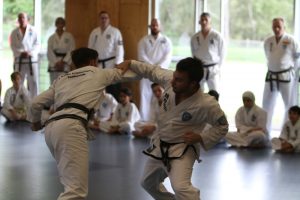
A joint lock is a manipulation technique where the joints of the opponent are manipulated to their maximal degree of motion, so that the joints cannot move any further and thus, get “locked”. In this locked position, there is zero or very little pain to the opponent. Since the opponent is unable to move, the opponent usually submits. Hence, law enforcement agencies generally use joint locks as a restraint technique, so that handcuffs may be applied or secure movement from one place to another may be undertaken. Joint locks are used as a self-defense technique in martial arts like Taekwondo, Karate, Krav Maga, Wing Chun, Kung Fu, Eskrima, and more. It is also used as a submission move in grappling martial arts like Jujutsu, Taijutsu, Brazilian jiu-jitsu, Aikido, Hapkido, Judo, and Sambo.
Samir Seif video “Hammer Lock for Law Enforcement and Security”:
If the opponent refuses to submit, then the locked joint may be further leveraged; thereby, forcing the locked joint to move past its normal range of motion. Further leveraging results in pain, or damage of ligaments/ tendons/ muscles, or dislocation of the joint, or in extreme cases even bone fracture. If a joint lock is combined with any other technique, then it may result in a greater damage. For example, in Judo, joint locks that are executed while standing are usually forbidden to be combined with throws, as this combination carries a greater risk of more physical injury to the falling opponent.
Global Wing Chun Academy video “Wing Chun Joint Lock | Global Wing Chun Academy”:
In Korean martial arts like Taekkyon, Ssireum, Taekwondo, Hapkido, etc., joint locks are usually known as “gwan-jerl-gi” (roughly translated as joint skill) or “gwan-jerl-kerk-gi” (roughly translated as joint breaking). In Chinese martial arts like Tai Chi, Hsing-I, Bagua, Kung Fu, etc., it is usually known as “chin na or qin na” (roughly translated as catching and locking); whereas, in Japanese martial arts like Judo, Karate, Jujutsu, etc., it is usually known as “kansetsu-waza” (roughly translated as joint locking technique).
Elite M.A. Centers video “Black Belts TKD Self-defense – Joint Locks / Breaks #7”:
Broad classification of joint locks
Joint locks may be classified in various ways; however, the most common classification is according to the area of the body where the lock is applied. A very broad classification is given below and each of the following can be further classified according to their respective individual variations.
-Neck
—Neck locks
-Spine
—Spinal locks
-Arm
—Arm locks
—Shoulder locks
—Elbow locks
—Wrist locks
—Finger locks
-Leg
—Leg locks
—Hip locks
—Knee locks
—Ankle locks
—Toe locks
All joint locks carry an amount of risk; however, joint locks involving the neck and the spine carry more risk and are thus, generally banned from several combat sports.
TaekwonWoo video “Top 10 Easy Wrist Locks and Release You Should Know | Self-Defense | TaekwonWoo How To”:
The basic premise behind all joint locks is to leverage the joints by pulling, or pushing, or twisting, or bending, or straightening, or rotating the joints, generally in a reverse manner, so that the joints move to their maximum natural range of motion and cannot move any further; thus, getting “locked”. The locked joints may be leveraged further by hyper-extension, or hyper-rotation, or hyper-flexion, in any direction, which may be vertical, horizontal, lateral, diagonal, or rotational. Further leveraging results in pain, and sudden or forceful leveraging may result in severe injury of the locked joints.
SHAOLIN TEMPLE LITHUANIA video “72 Qinna. Joint locking and manipulation techniques. Part 2”:
Conclusion
While practicing joint locking techniques, one should also practice the correct footwork, correct flexibility of one’s own joints, and correct breathing. Students should practice all joint locks in a slow and controlled manner, so that no training partner is hurt. A training partner is required, since real experience of the training partner’s resistance and feedback is obtained. However, it should be noted that the training partner should also be trained in the execution of joint locks, as an untrained partner may easily get accidentally hurt. In the absence of a training partner, visualization may help to practice the different locks with an imaginary opponent. Imagination or visualization, may be done mentally with no physical movement at all, or with some physical movement, or executing the full physical movement towards an imaginary opponent.
Reference:
1. Kelly, P. W. (1996). webpage. U.S. Department of Justice, Office of Justice Programs. “Learning How to Pick That Lock: Tactical Enhancement of Joint Locks, Come-Alongs, and Pain Compliance Techniques”. Available at: https://www.ojp.gov/ncjrs/virtual-library/abstracts/learning-how-pick-lock-tactical-enhancement-joint-locks-come-alongs [Accessed on August 12, 2022].
Need high-quality martial arts gear at reasonable prices?
Pacific Sports (a subsidiary of Pacific International Taekwondo) offers a range of high-quality, functional and affordable Taekwondo and Karate uniforms, as well as Martial Art and Kickboxing equipment, Kick Boxing Shorts, MMA Rash Guards, MMA Gloves, TKD paddles, Shin Guards, Kick Shield, Instep Pad Guards, Focus Pads, Focus Mitts, TKD shoes and Gel Hand Wraps, anywhere in Australia.
Avail the benefits of discounts, free shipping and clearance sales.
PACIFIC SPORTS
Phone:
+61 415383635
Email:
info@pacific-sports.com
Website:
https://pacific-sports.com



